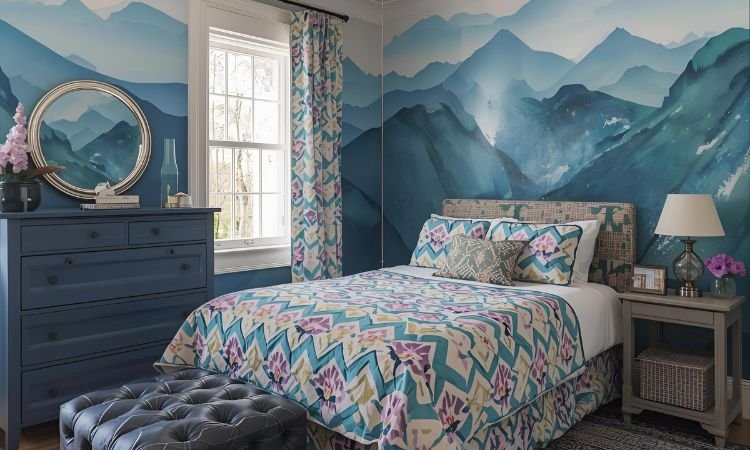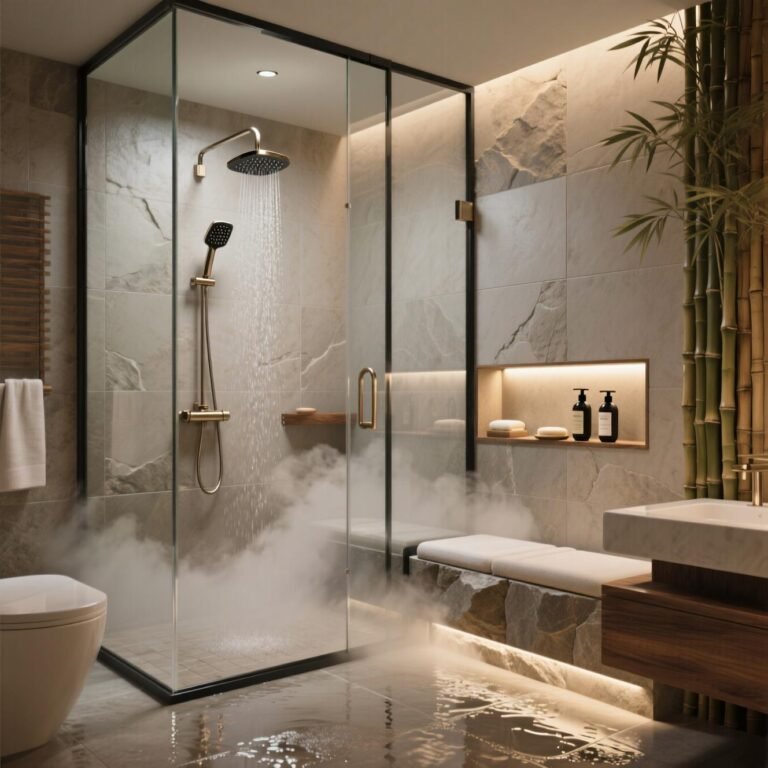Genius Small Kids Room Ideas to Keep Things Cute and Organized

Small kids’ rooms often present a unique challenge: how to fit everything a child needs—a bed, storage, play space, and perhaps a study area—without feeling cramped or overwhelming. A poorly organized small room can lead to constant clutter, limit play, and make it difficult for children to truly enjoy their personal space. The goal is to transform these compact areas into efficient, inspiring, and comfortable havens that grow with their occupants.
We’re covering 13 imaginative small kids’ room ideas, featuring everything from vertical storage to adaptable furniture and multi-functional layouts. These selections prioritize clever space utilization, safety, and a balance of fun and practicality, demonstrating that even the smallest room can be big on charm and utility.
Get ready to discover creative ways to maximize storage, enhance play, and personalize a compact room that feels expansive and inviting.
Key Strategies for Compact Kids’ Rooms
- Go Vertical with Storage: Utilize wall space with tall units, floating shelves, and wall-mounted organizers. It’s like stacking vertically where every available height is used. Drawing the eye upward makes a room feel more expansive.
- Embrace Multi-Functional Furniture: Choose pieces that serve more than one purpose, like a bed with built-in drawers or a desk that folds away. It’s like versatile equipment where adaptability is essential. Multi-purpose items reduce the need for numerous separate pieces.
- Light Colors Expand Space: Use light paint colors and natural tones on walls and larger furniture items. It’s like an optical illusion where brightness creates openness. Lighter shades reflect light, making a room feel larger and airier.
- Clear the Floor: Keep floor space as open as possible for play and movement. It’s like a clear stage where activities can unfold freely. An uncluttered floor makes a small room feel less restrictive.
13 Small Kids Room Ideas
Discover innovative ways to create organized, stimulating, and spacious-feeling environments in compact kids’ rooms.
1. Loft or Bunk Beds with Integrated Storage
Install a loft bed or bunk bed system that includes built-in desks, shelving, or drawers underneath, effectively creating multiple zones in a single footprint. This strategy is perfect for maximizing limited floor space, providing distinct areas for sleeping, studying, or playing. It’s like a compact, multi-level living unit designed for efficiency.
Choose sturdy frames with secure ladders or stairs, ensuring ample headroom for the child using the lower section. This approach allows for a full study station or play area where a standard bed would occupy the entire floor.
2. Wall-Mounted Fold-Down Desk
Integrate a desk that folds flat against the wall when not in use, offering a practical workspace that disappears to free up precious floor space for play. This highly adaptable solution is ideal for very small rooms or spaces that serve multiple functions throughout the day. It’s like a flexible workstation where room utility changes with needs.
Ensure the desk is securely mounted and easy for a child to operate safely. Pair it with wall-mounted shelves or a pegboard above to keep study essentials accessible even when the desk is closed.
3. Vertical Wall Storage Systems
Utilize wall-mounted shelving units, cubbies, or even full-height bookcases that draw the eye upward, making the room feel taller and more spacious. This maximizes storage capacity without encroaching on valuable floor area. It’s like an efficient vertical filing system where every object has its place off the ground.
Choose units that are securely anchored to the wall and offer a mix of open shelves for display and closed compartments for hiding clutter. Label bins and baskets for easy organization and retrieval.
4. Under-Bed Storage Solutions
Incorporate pull-out drawers, rolling bins, or a trundle bed for sleepovers, all designed to fit neatly under the main bed frame. This utilizes often-overlooked space for storing toys, out-of-season clothes, or extra bedding. It’s like hidden treasure where practical items are tucked away.
Look for solutions with wheels for easy access and covers to protect contents from dust. This keeps the main floor area clear, allowing more space for play and movement.
5. Bright and Light Color Palette
Paint walls in light, neutral colors such as soft whites, pale grays, or light pastels. These shades reflect natural light, making the room feel larger, airier, and more open. It’s like an optical illusion where lightness expands the perception of space.
Introduce pops of color through bedding, accessories, and artwork, which can be easily changed as the child’s preferences evolve. This creates a versatile backdrop that grows with them.
6. Minimalist Furniture Choices
Select furniture pieces with clean lines, slender profiles, and minimal ornamentation to avoid making the room feel heavy or overcrowded. Prioritize functionality over bulk. It’s like streamlined design where efficiency and aesthetic balance.
Consider transparent or lucite chairs that visually disappear, or open-leg desks that allow light and sightlines to pass through, further enhancing the sense of space.
7. Mirror Placement for Illusion
Strategically place a large mirror on a wall to reflect light and create the illusion of a larger, deeper room. This visual trick can instantly make a compact space feel more expansive. It’s like a visual extension where reflections multiply space.
Ensure the mirror is securely mounted to the wall and framed with child-safe, rounded edges. Place it opposite a window or an interesting feature for the best effect.
8. Closet Transformation
Convert a traditional closet into a multi-functional zone, such as a compact study nook with a built-in desk and shelves, or a cozy reading alcove. This maximizes an often-underutilized architectural feature within the room. It’s like a secret hideaway where a new function is discovered.
Remove closet doors to open up the space and install good task lighting. This creates a dedicated area for quiet activities without consuming additional floor space.
9. Rolling Storage Cart
Utilize a multi-tiered rolling utility cart for toys, art supplies, or books. Its mobility allows it to be moved out of the way when floor space is needed for play, or brought close during activities. It’s like a versatile caddy where items are always within reach.
Look for carts with sturdy wheels and brakes for safety and stability. This offers flexible storage that adapts to the changing needs of a dynamic child’s room.
10. Door-Mounted Organizers
Install over-the-door organizers with clear pockets or shelves on the back of the room’s entry door or closet door. This provides hidden storage for small toys, shoes, or accessories, utilizing an often-forgotten vertical surface. It’s like an invisible assistant where convenience meets concealment.
Choose organizers that are durable and securely attached to prevent swinging or falling. This keeps clutter off shelves and out of drawers, freeing up primary storage.
11. Built-In Nooks and Shelves
Design custom built-in shelving, benches with storage, or recessed nooks that fit perfectly into awkward corners or wall indentations. This maximizes every unique architectural feature of the room. It’s like tailored craftsmanship where space is sculpted for purpose.
Built-ins create a seamless look, making the room appear less cluttered and more integrated. They offer robust storage without adding freestanding furniture that takes up floor space.
12. Transparent Storage Bins
Opt for clear or semi-transparent storage bins for toys and craft supplies. This allows children to easily see what’s inside, encouraging them to put items back where they belong and reducing the need to empty bins to find things. It’s like an X-ray vision organizer where contents are always visible.
This visual transparency helps maintain a sense of order and can prevent items from being forgotten at the bottom of opaque containers. It makes clean-up more efficient for both kids and parents.
13. Smart Furniture Arrangement
Carefully plan the layout by positioning the bed against the longest wall to create a sense of spaciousness, and place other furniture to maintain clear pathways. This strategic arrangement optimizes traffic flow and makes the room feel less cramped. It’s like a spatial puzzle where every piece fits perfectly.
Avoid placing large furniture pieces directly in front of windows, which can block natural light and visually shrink the room. A well-considered layout can make a small room feel much larger.
Crafting Cozy and Clever Spaces
- Edit Regularly: Periodically go through toys, clothes, and books with your child, donating or discarding items that are no longer needed. This prevents accumulation and keeps the room functional. It’s like a continuous declutter where efficiency is maintained.
- Create Zones: Even in a small room, use rugs, small dividers, or furniture placement to subtly define areas for sleep, play, and study. This helps organize activities without rigid barriers. It’s like a flexible floor plan where different functions coexist.
- Involve Your Child: Empower your child to help choose furniture or organizational systems. This fosters a sense of ownership and encourages them to keep their space tidy. It’s like a collaborative project where their input matters.
Frequently Asked Questions About Small Kids’ Rooms
How can I maximize storage in a tiny kids’ room?
To maximize storage in a tiny kids’ room, go vertical with tall shelves, wall-mounted cubbies, and door organizers. Choose multi-functional furniture like a captain’s bed with drawers or an ottoman with storage. Utilize under-bed space with rolling bins and integrate storage into built-in units or closet conversions.
Every available surface, from behind doors to under windows, can offer storage potential if approached creatively.
What colors make a small room look bigger?
Light and cool colors, such as soft whites, pale grays, pastels like mint green or sky blue, are excellent choices for making a small room look bigger. These shades reflect light, creating an airy and open feel.
Avoid dark, heavy colors on all walls, which can make a room feel enclosed. If you want to introduce darker tones, do so as an accent on one wall or through smaller decor items.
Is a loft bed a good idea for a small room?
Yes, a loft bed is often an excellent idea for a small room as it maximizes vertical space, freeing up valuable floor area underneath for a desk, play zone, or extra storage. This design effectively creates two functional areas in the footprint of one.
Consider the child’s age and ability to safely climb. Ensure the loft bed is sturdy, securely assembled, and has appropriate guardrails for safety.
How do I keep a small kids’ room from looking cluttered?
To keep a small kids’ room from looking cluttered, prioritize effective storage solutions where every item has a designated home. Use clear or labeled bins to make tidying easier. Regularly declutter and involve your child in the process of putting things away.
Opt for multi-functional furniture and wall-mounted storage to keep the floor clear. Maintain a minimalist approach to decor to prevent visual overwhelm.
How can I create a play area in a small room?
To create a play area in a small room, use flexible furniture like a fold-down desk or a bed with under-bed storage to free up floor space when needed. A soft, engaging rug can define a play zone without permanent barriers.
Utilize vertical storage for toys, and consider a mobile cart that can hold play items and be moved aside. Focus on creating a clear, open central area for active play.
Designing for Growth in Every Corner
Designing a small kids’ room is an exciting challenge that, when met with creativity and smart planning, can yield truly remarkable results. By focusing on vertical solutions, multi-functional pieces, and a clear aesthetic, you transform limited square footage into an expansive world of possibilities. Each thoughtful choice in furniture and layout ensures that their personal space supports their evolving needs, fostering both fun and order.
Begin by assessing your child’s age and essential activities, then select ideas that maximize every inch while creating an inviting atmosphere. Remember, even the coziest room can hold the biggest dreams.
Which of these small kids’ room ideas will you implement to create more space and joy? Share your favorite compact solutions below!






